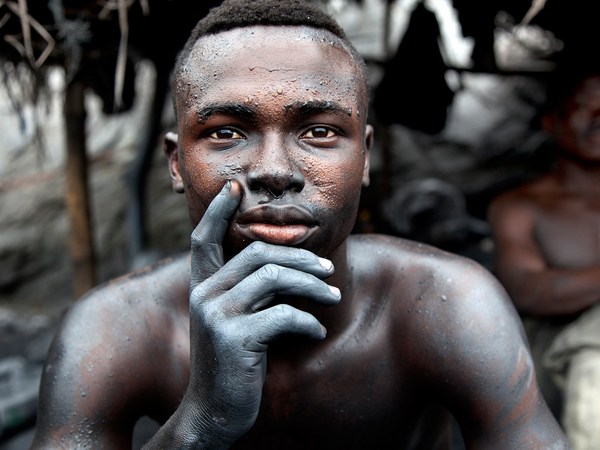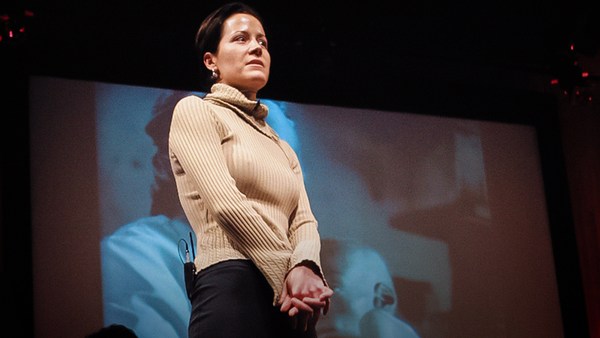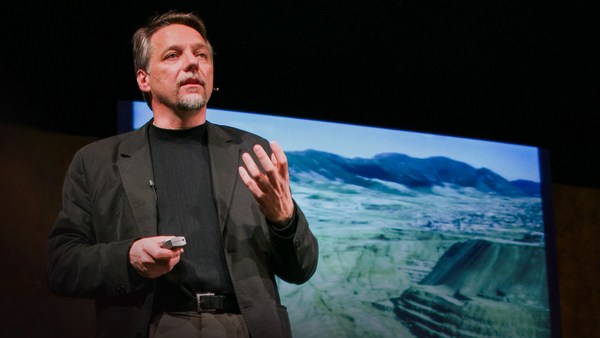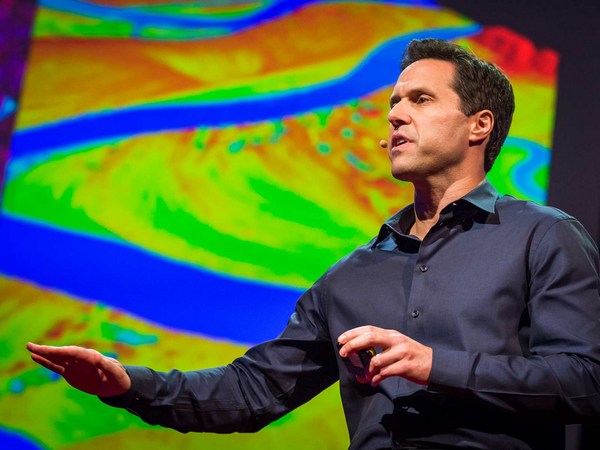I'm not sure that every person here is familiar with my pictures. I want to start to show just a few pictures to you, and after I'll speak.
I must speak to you a little bit of my history, because we'll be speaking on this during my speech here. I was born in 1944 in Brazil, in the times that Brazil was not yet a market economy. I was born on a farm, a farm that was more than 50 percent rainforest [still]. A marvelous place. I lived with incredible birds, incredible animals, I swam in our small rivers with our caimans. It was about 35 families that lived on this farm, and everything that we produced on this farm, we consumed. Very few things went to the market. Once a year, the only thing that went to the market was the cattle that we produced, and we made trips of about 45 days to reach the slaughterhouse, bringing thousands of head of cattle, and about 20 days traveling back to reach our farm again.
When I was 15 years old, it was necessary for me to leave this place and go to a town a little bit bigger -- much bigger -- where I did the second part of secondary school. There I learned different things. Brazil was starting to urbanize, industrialize, and I knew the politics. I became a little bit radical, I was a member of leftist parties, and I became an activist. I [went to] university to become an economist. I [did] a master's degree in economics.
And the most important thing in my life also happened in this time. I met an incredible girl who became my lifelong best friend, and my associate in everything that I have done till now, my wife, Lélia Wanick Salgado.
Brazil radicalized very strongly. We fought very hard against the dictatorship, in a moment it was necessary to us: Either go into clandestinity with weapons in hand, or leave Brazil. We were too young, and our organization thought it was better for us to go out, and we went to France, where I did a PhD in economics, Léila became an architect. I worked after for an investment bank. We made a lot of trips, financed development, economic projects in Africa with the World Bank.
And one day photography made a total invasion in my life. I became a photographer, abandoned everything and became a photographer, and I started to do the photography that was important for me. Many people tell me that you are a photojournalist, that you are an anthropologist photographer, that you are an activist photographer. But I did much more than that. I put photography as my life. I lived totally inside photography doing long term projects, and I want to show you just a few pictures of -- again, you'll see inside the social projects, that I went to, I published many books on these photographs, but I'll just show you a few ones now.
In the '90s, from 1994 to 2000, I photographed a story called Migrations. It became a book. It became a show.
But during the time that I was photographing this, I lived through a very hard moment in my life, mostly in Rwanda. I saw in Rwanda total brutality. I saw deaths by thousands per day. I lost my faith in our species. I didn't believe that it was possible for us to live any longer, and I started to be attacked by my own Staphylococcus. I started to have infection everywhere. When I made love with my wife, I had no sperm that came out of me; I had blood. I went to see a friend's doctor in Paris, told him that I was completely sick. He made a long examination, and told me, "Sebastian, you are not sick, your prostate is perfect. What happened is, you saw so many deaths that you are dying. You must stop. Stop. You must stop because on the contrary, you will be dead."
And I made the decision to stop. I was really upset with photography, with everything in the world, and I made the decision to go back to where I was born. It was a big coincidence. It was the moment that my parents became very old. I have seven sisters. I'm one of the only men in my family, and they made together the decision to transfer this land to Léila and myself. When we received this land, this land was as dead as I was. When I was a kid, it was more than 50 percent rainforest. When we received the land, it was less than half a percent rainforest, as in all my region. To build development, Brazilian development, we destroyed a lot of our forest. As you did here in the United States, or you did in India, everywhere in this planet. To build our development, we come to a huge contradiction that we destroy around us everything. This farm that had thousands of head of cattle had just a few hundreds, and we didn't know how to deal with these. And Léila came up with an incredible idea, a crazy idea.
She said, why don't you put back the rainforest that was here before? You say that you were born in paradise. Let's build the paradise again.
And I went to see a good friend that was engineering forests to prepare a project for us, and we started. We started to plant, and this first year we lost a lot of trees, second year less, and slowly, slowly this dead land started to be born again. We started to plant hundreds of thousands of trees, only local species, only native species, where we built an ecosystem identical to the one that was destroyed, and the life started to come back in an incredible way. It was necessary for us to transform our land into a national park. We transformed. We gave this land back to nature. It became a national park. We created an institution called Instituto Terra, and we built a big environmental project to raise money everywhere. Here in Los Angeles, in the Bay Area in San Francisco, it became tax deductible in the United States. We raised money in Spain, in Italy, a lot in Brazil. We worked with a lot of companies in Brazil that put money into this project, the government. And the life started to come, and I had a big wish to come back to photography, to photograph again. And this time, my wish was not to photograph anymore just one animal that I had photographed all my life: us. I wished to photograph the other animals, to photograph the landscapes, to photograph us, but us from the beginning, the time we lived in equilibrium with nature. And I went. I started in the beginning of 2004, and I finished at the end of 2011. We created an incredible amount of pictures, and the result -- Lélia did the design of all my books, the design of all my shows. She is the creator of the shows. And what we want with these pictures is to create a discussion about what we have that is pristine on the planet and what we must hold on this planet if we want to live, to have some equilibrium in our life. And I wanted to see us when we used, yes, our instruments in stone. We exist yet. I was last week at the Brazilian National Indian Foundation, and only in the Amazon we have about 110 groups of Indians that are not contacted yet. We must protect the forest in this sense. And with these pictures, I hope that we can create information, a system of information. We tried to do a new presentation of the planet, and I want to show you now just a few pictures of this project, please.
Well, this — (Applause) — Thank you. Thank you very much.
This is what we must fight hard to hold like it is now. But there is another part that we must together rebuild, to build our societies, our modern family of societies, we are at a point where we cannot go back. But we create an incredible contradiction. To build all this, we destroy a lot. Our forest in Brazil, that antique forest that was the size of California, is destroyed today 93 percent. Here, on the West Coast, you've destroyed your forest. Around here, no? The redwood forests are gone. Gone very fast, disappeared. Coming the other day from Atlanta, here, two days ago, I was flying over deserts that we made, we provoked with our own hands. India has no more trees. Spain has no more trees.
And we must rebuild these forests. That is the essence of our life, these forests. We need to breathe. The only factory capable to transform CO2 into oxygen, are the forests. The only machine capable to capture the carbon that we are producing, always, even if we reduce them, everything that we do, we produce CO2, are the trees. I put the question -- three or four weeks ago, we saw in the newspapers millions of fish that die in Norway. A lack of oxygen in the water. I put to myself the question, if for a moment, we will not lack oxygen for all animal species, ours included -- that would be very complicated for us.
For the water system, the trees are essential. I'll give you a small example that you'll understand very easily. You happy people that have a lot of hair on your head, if you take a shower, it takes you two or three hours to dry your hair if you don't use a dryer machine. Me, one minute, it's dry. The same with the trees. The trees are the hair of our planet. When you have rain in a place that has no trees, in just a few minutes, the water arrives in the stream, brings soil, destroying our water source, destroying the rivers, and no humidity to retain. When you have trees, the root system holds the water. All the branches of the trees, the leaves that come down create a humid area, and they take months and months under the water, go to the rivers, and maintain our source, maintain our rivers. This is the most important thing, when we imagine that we need water for every activity in life.
I want to show you now, to finish, just a few pictures that for me are very important in that direction. You remember that I told you, when I received the farm from my parents that was my paradise, that was the farm. Land completely destroyed, the erosion there, the land had dried. But you can see in this picture, we were starting to construct an educational center that became quite a large environmental center in Brazil. But you see a lot of small spots in this picture. In each point of those spots, we had planted a tree. There are thousands of trees. Now I'll show you the pictures made exactly in the same point two months ago.
(Applause)
I told you in the beginning that it was necessary for us to plant about 2.5 million trees of about 200 different species in order to rebuild the ecosystem. And I'll show you the last picture. We are with two million trees in the ground now. We are doing the sequestration of about 100,000 tons of carbon with these trees.
My friends, it's very easy to do. We did it, no? By an accident that happened to me, we went back, we built an ecosystem. We here inside the room, I believe that we have the same concern, and the model that we created in Brazil, we can transplant it here. We can apply it everywhere around the world, no? And I believe that we can do it together.
Thank you very much.
(Applause)





